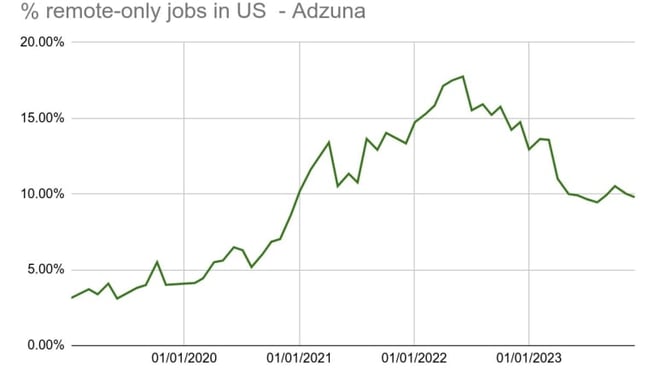Remote-Only Hiring Continues to Drop: 7 Factors Driving the Trend

Article originally published by shrm.org on December 13, 2023. Written by Joseph Romsey.
Remote work skyrocketed during the COVID-19 pandemic, becoming part of the new normal for many businesses. Although remote work was forced upon employers by a global health crisis, it allowed them to geographically expand their talent pool and meet some of their inclusion, equity and diversity goals. The number of U.S. residents working "remote-first" more than tripled from 9 million in 2019 to 27.6 million in 2021, according to the U.S. Census Bureau.
But since 2022, the remote-only hiring trend has been moving in the opposite direction.
Remote Job Listings Reach a 3-Year Low
"Remote job postings have now declined to the lowest share of new job postings in the last three years," said Lauren Hasson, senior vice president, workplace strategy at commercial real estate firm JLL. "That share peaked in January of 2022 at 20.7 percent, but has declined to 9.1 percent as of August of 2023, according to LinkedIn's job data."
James Neave, head of data science at job search engine Adzuna, has seen the same trend line in his data. "Prior to 2020, remote-only listings were just 3-4 percent of our total listings. That percentage started to grow during the pandemic, peaking at around 18 percent in the middle of 2022," he said. "But in 2023, remote-only listings have steadily and significantly declined to just below 10 percent of all listings."

Why are employers posting fewer remote-only job ads, and what will happen with remote-only hiring in 2024 and beyond?
7 Factors Driving the Decline
Experts said the following issues are contributing to the drop in remote-only job listings:
1. Remote-only hiring can create two unequal classes of employees. Hasson said that having two distinct classes of employees, remote and onsite/hybrid, created big challenges in treating both groups equitably.
"It's challenging for organizations to ensure that both groups have the same access to mentoring and development, learning opportunities, and access to leadership," she said. "Fully remote employees can sometimes become the forgotten class." In particular, Hasson added, workers who attend meetings remotely miss out on crucial opportunities to chat with others beforehand and afterwards.
2. Multistate tax and compliance concerns. "Some of our clients have been digging out from underneath a lot of paperwork related to remote-only hiring and having employees working remotely from other states," Hasson said. "Organizations want to find a way to keep their talent and make everything work, but complexities around taxes and compliance can present challenges."
3. Generational preferences for onsite work. "There's often a split between younger and older employees about working remotely," Neave said. "People early in their careers value being in the office to network and to learn new skills. Later in careers, people may not need to learn as much and also might have kids, elderly relatives and other commitments at home."
Declan Daly, managing partner at Bundoran Group, a recruitment agency, has noticed some misconceptions about which generations want to work in person. "I've been reading about how Baby Boomers are blaming Millennials for wanting to work remotely, but the Millennials I talk to prefer to go into the office," he said. "It's the Boomers who I hear complaining the most about long commutes. Gen Z college graduates, on the other hand, tell me they wouldn't even consider a job unless there was an office component. They don't want to work remote-only."
4. Concerns about lower productivity of remote-only workers. A 2023 study co-authored by Stanford University professor Nicholas Bloom found that fully remote work appeared to lower average productivity by between 10 percent and 20 percent. Other research published this year by the National Bureau of Economic Research seemed to support the Stanford study, but the authors said more research needs to be done.
For example, the authors of both studies said they didn't take into account the real estate costs companies might have saved with a remote-first approach.
5. Nostalgia among leaders for the pre-pandemic workplace. After three years of dizzying workplace change, many business leaders seem to want a return to the workplace of 2019, according to Neave. "There seems to be a combination of risk aversion, nostalgia and laziness among some business leaders who are either uncomfortable or unwilling to invest resources into effectively supporting remote-only work," he said. "These leaders don't quite understand how organizations can trust people to do their work at home and not be lazy."
6. Complexities around fostering an organizational culture. Many organizations have invested in technologies and policies to address the complexities of connecting and managing distributed teams, but massive challenges remain. "It's definitely easier to build an organizational culture if all your people are in the office, interacting with each other face-to-face," Neave said. "Leaders are asking themselves, 'How the heck can we build a company culture when so many of our people are working remotely?' This has become one of the most powerful arguments for bringing people back to the office."
Hasson noted that in-person work can also be more meaningful. "Having employees back in the office has reminded us about the power and impact of bringing people together, how much more innovative people can be and how much easier it is to collaborate and give feedback when you've spent in-person time with others," she said.
7. The impact of AI and automation. Routine and repetitive jobs may soon be replaced by artificial intelligence, Neave said. "So instead of hiring remote-only employees, an organization might eliminate or reduce the number of roles and replace people with ChatGPT or automation tools," he explained. "That negatively impacts remote hiring."
What’s Next for Remote-Only Hiring?
Neave predicted that remote-only hiring will further decline next year. "I expect remote-only listings to continue decreasing in 2024, but the percentage will eventually stabilize somewhere between 5 percent to 8 percent of all listings," he said. While that's still double the pre-pandemic level, it's far from the 2022 peak.
Hasson agreed that remote-only jobs will drop off, but she doesn't expect the same for workers who combine remote and in-person work. "Just because fully remote hiring is starting to taper off, it doesn't mean everybody's going back to the office five days a week. Hybrid and flexible work are here to stay," she said. "They enable organizations to offer their employees more choice and control, but lets you bring people together to build relationships and increase opportunities for learning, mentoring and development."